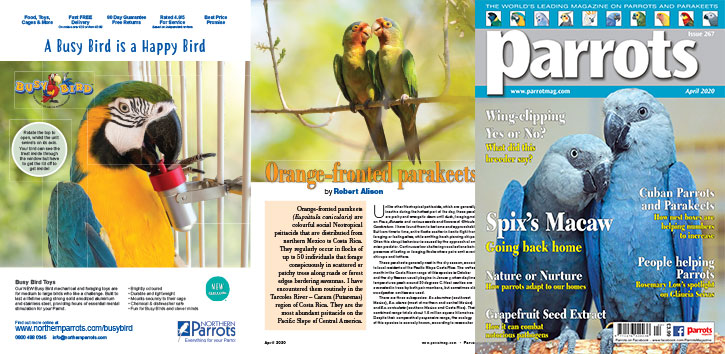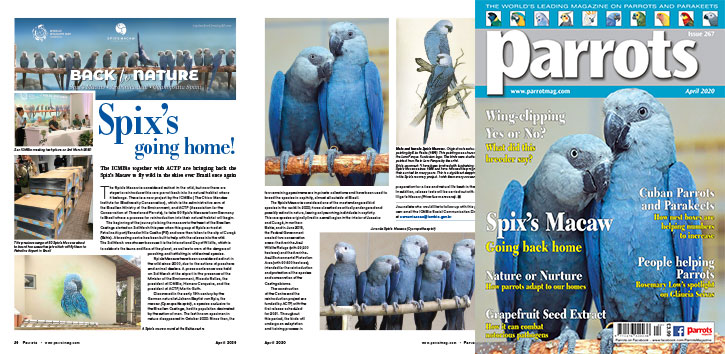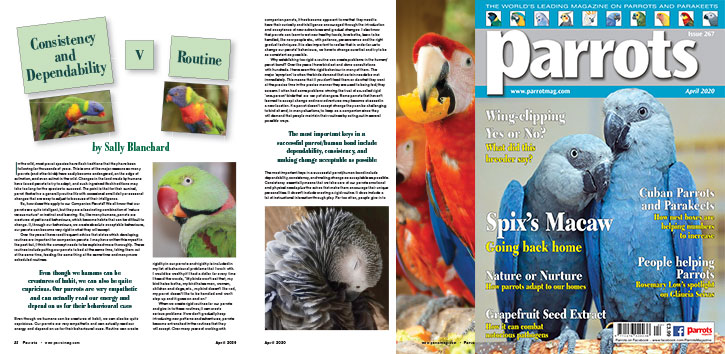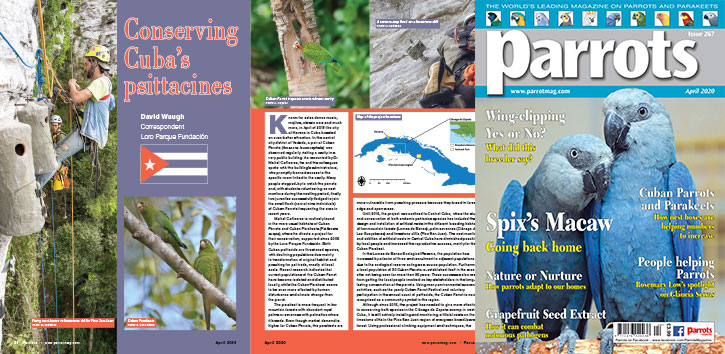
By Robert Alison
Orange-fronted parakeets (Eupsittula canicularis) are colourful social Neotropical psittacids that are distributed from northern Mexico to Costa Rica. They regularly occur in flocks of up to 50 individuals that forage conspicuously in scattered or patchy trees along roads or forest edges bordering savannas. I have encountered them routinely in the Tarcoles River – Carara (Putarenas) region of Costa Rica. They are the most abundant psittacids on the Pacific Slope of Central America.
Unlike other Neotropical psittacids, which are generally inactive during the hottest part of the day, these parakeets are perky and energetic dawn until dusk, foraging noisily on Ficus, Burseria and various seeds and flowers of Gliricula and Combretum. I have found them to be tame and approachable. But from time to time, entire flocks scatter in frantic flight from foraging or loafing sites, while emitting harsh piercing chirps. Often this abrupt behaviour is caused by the approach of an avian predator. Continuous low chattering vocalisations betray the presence of loafing or foraging flocks where pairs emit a variety of chirrups and twitters.
These parakeets generally nest in the dry season, according to local residents of the Pacific Slope Costa Rica. The wettest month in the Costa Rican range of this species is October and the dry Season usually begins in January, when daytime temperatures peak around 30 degrees C. Nest cavities are excavated in trees by both pair members, but sometimes old woodpecker cavities are used.
Buy Now!

The ICMBio together with ACTP are bringing back the Spix’s Macaw to fly wild in the skies over Brazil once again
The Spix’s Macaw is considered extinct in the wild, but now there are steps to reintroduce this rare parrot back into its natural habitat where it belongs. There is a new project by the ICMBio (The Chico Mendes Institute for Biodiversity Conservation), which is the administrative arm of the Brazilian Ministry of the Environment, and ACTP (Association for the Conservation of Threatened Parrots), to take 50 Spix’s Macaws from Germany to Brazil where a process for reintroduction into their natural habitat will begin.
The beginning of the journey to bring the macaws to the heart of the Brazilian Caatinga started on 3rd March this year when this group of Spix’s arrived at Petrolina Airport/Senador Nilo Coelho (PE) and were then taken to the city of Curaçá (Bahia). A breeding centre has been built to help with the release into the wild. The 3rd March was chosen because it is the International Day of Wildlife, which is to celebrate the fauna and flora of the planet, as well as to warn of the dangers of poaching and trafficking in wild animal species.
Spix’s Macaws have been considered extinct in the wild since 2000, due to the actions of poachers and animal dealers. A press conference was held on 3rd March at the airport in the presence of the Minister of the Environment, Ricardo Salles, the president of ICMBio, Homero Cerqueira, and the president of ACTP, Martin Guth.
Buy Now!

By Sally Blanchard
In the wild, most parrot species have flock traditions that they have been following for thousands of years. This is one of the major reasons so many parrots (and other birds) have sadly become endangered, on the edge of extinction, and even extinct in the wild. Changes in the land made by humans have forced parrots to try to adapt, and such ingrained flock traditions may take too long for the species to succeed. The point is that for their survival, parrot flocks live a generally routine life with occasional small daily or seasonal changes that are easy to adjust to because of their intelligence.
So, how does this apply to our Companion Parrots? We all know that our parrots are quite intelligent, but they are a fascinating combination of ‘nature versus nurture’ or instinct and learning. So, like many humans, parrots are creatures of patterned behaviours, which become habits that can be difficult to change. If, through our behaviours, we create absolute acceptable behaviours, our parrots can become very rigid in what they will accept.
Over the years I have read frequent advice that states which developing routines are important for companion parrots. I may have written this myself in the past but, I think the concept needs to be explained more thoroughly. These routines include putting our parrots to bed at the same time, taking them out at the same time, feeding the same thing at the same time and many more scheduled routines.
Buy Now!

David Waugh, Correspondent, Loro Parque Fundación
Known for salsa dance music, mojitos, classic cars and much more, in April of 2019 the city of Havana in Cuba boasted an even better attraction. In the central city district of Vedado, a pair of Cuban Parrots (Amazona leucocephala) was observed regularly visiting a cavity in a very public building. As recounted by Dr Maikel Cañizares, he and his colleagues spoke with the building’s administrators, who promptly banned access to the specific room linked to the cavity. Many people stopped-by to watch the parrots and, with students volunteering as nest monitors during the nestling period, finally two juveniles successfully fledged to join the small flock (now of nine individuals) of Cuban Parrots frequenting the area in recent years.
Maikel Cañizares is routinely found in the more usual habitats of Cuban Parrots and Cuban Parakeets (Psittacara euops), where he directs a project for their conservation, supported since 2005 by the Loro Parque Fundación. Both Cuban psittacids are threatened species, with declining populations due mainly to transformation of original habitat and poaching for pet trade, mostly at local scale. Recent research indicates that current populations of the Cuban Parrot have become isolated and distributed locally, while the Cuban Parakeet seems to be even more affected by human disturbance and climate change than the parrot.
The parakeet is more frequent in low mountain forests with abundant royal palms or savannas with palmettos where it breeds. Even though market demand is higher for Cuban Parrots, the parakeets are more vulnerable from poaching pressure because they breed in forest edge and open areas.
Buy Now!




